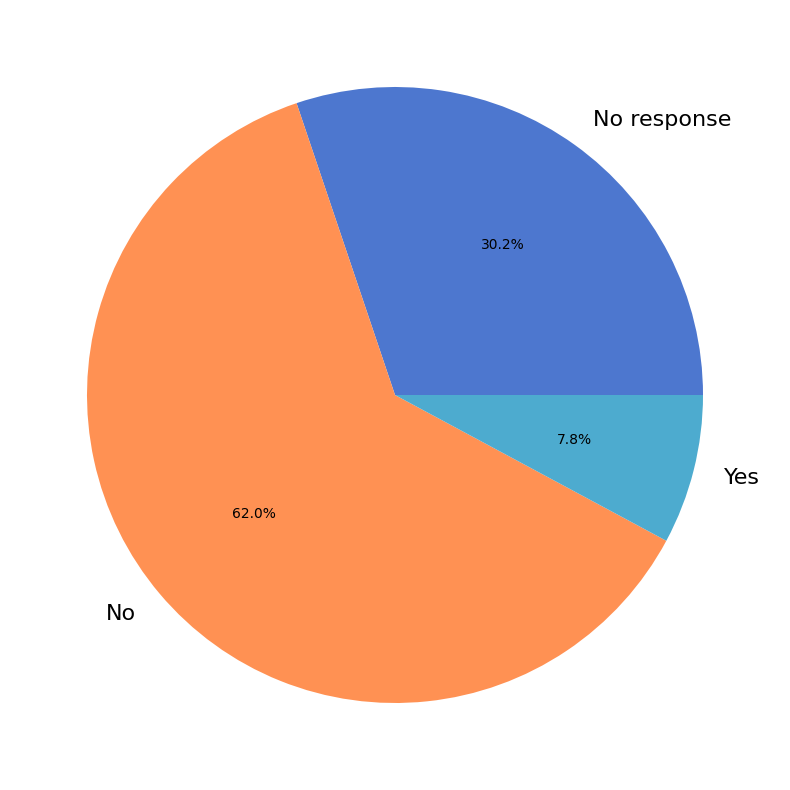Community#
A summary of the demographic information of the NumPy survey respondents.
Show code cell source
fname = "data/2020/numpy_survey_results.tsv"
column_names = [
'age', 'gender', 'lang', 'lang_other', 'country', 'degree', 'degree_other',
'field_of_study', 'field_other', 'role', 'role_other', 'version',
'primary_use', 'programming_exp', 'numpy_exp', 'use_freq', 'components',
'use_c_ext', 'prog_lang', 'prog_lang_other',
]
demographics_dtype = np.dtype({
"names": column_names,
"formats": ['<U600'] * len(column_names),
})
data = np.loadtxt(
fname, delimiter='\t', skiprows=3, dtype=demographics_dtype,
usecols=range(11, 31), comments=None
)
glue('num_respondents', data.shape[0], display=False)
Demographics#
Age#
Of the 1236 survey respondents, 1089 (88%) shared their age.
Show code cell source
age = data['age']
# Preprocessing
ignore_chars = ('', '> 40')
for value in ignore_chars:
age = age[age != value]
age = age.astype(int)
# Distribution
bwidth = 10
bedges = np.arange(0, age.max() + bwidth, bwidth)
h, _ = np.histogram(age, bins=bedges)
h = 100 * h / h.sum()
fig, ax = plt.subplots(figsize=(12, 8))
x = np.arange(len(h))
ax.bar(x, h)
labels = [f"{low}-{high - 1}" for low, high in zip(bedges[:-1], bedges[1:])]
ax.set_xticks(x)
ax.set_xticklabels(labels)
fig.autofmt_xdate();
ax.set_title("Age Distribution of Survey Respondents");
ax.set_xlabel("Age (yrs)");
ax.set_ylabel("Percentage of Respondents");
glue('num_age_respondents', gluval(age.shape[0], data.shape[0]), display=False)
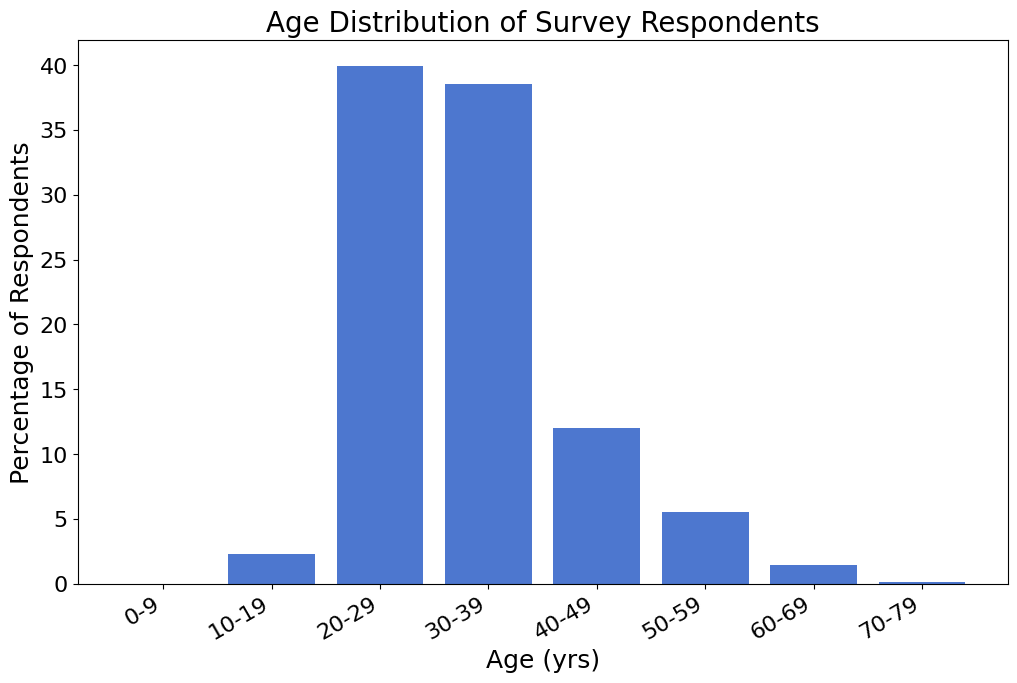
Gender#
Of the 1236 survey respondents, 1100 (89%) shared their gender.
Show code cell source
# Ignore empty fields and "prefer not to answer"
drop = np.logical_and(data['gender'] != '', data['gender'] != 'Prefer not to answer')
gender = data['gender'][drop]
labels, cnts = np.unique(gender, return_counts=True)
fig, ax = plt.subplots(figsize=(8, 8))
ax.pie(cnts, labels=labels, autopct='%1.1f%%')
ax.set_title("Gender Distribution of Survey Respondents");
fig.tight_layout()
glue('num_gender', gluval(gender.shape[0], data.shape[0]), display=False)
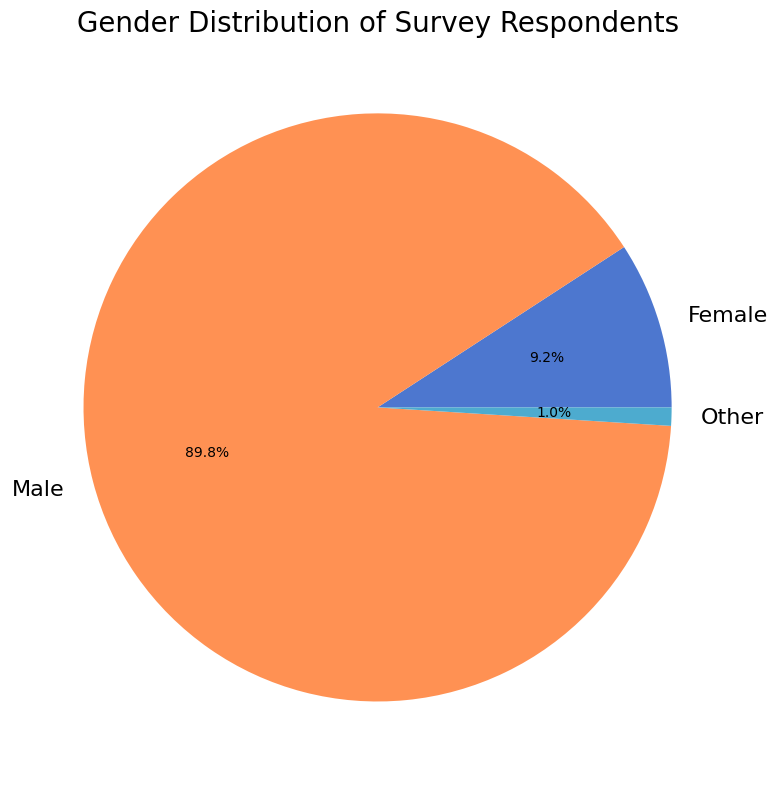
Language Preference#
Of the 1236 respondents, 1173 (95%) shared their preferred language.
Show code cell source
# Ignore empty fields
lang = data['lang'][data['lang'] != '']
# Self-reported language
lang_other = data['lang_other'][data['lang_other'] != '']
lang_other = capitalize(lang_other)
lang = np.concatenate((lang, lang_other))
labels, cnts = np.unique(lang, return_counts=True)
cnts = 100 * cnts / cnts.sum()
I = np.argsort(cnts)[::-1]
labels, cnts = labels[I], cnts[I]
# Create a summary table
with open('_generated/language_preference_table.md', 'w') as of:
of.write('| **Language** | **Preferred by % of Respondents** |\n')
of.write('|--------------|-----------------------------------|\n')
for lbl, percent in zip(labels, cnts):
of.write(f'| {lbl} | {percent:1.1f} |\n')
glue('num_lang_pref', gluval(lang.shape[0], data.shape[0]), display=False)
Click to show/hide table
Language |
Preferred by % of Respondents |
|---|---|
English |
69.5 |
Spanish |
8.3 |
Japanese |
6.7 |
Other |
3.8 |
French |
2.8 |
Portuguese |
2.0 |
Russian |
1.9 |
German |
1.4 |
Mandarin |
0.7 |
Chinese |
0.5 |
Arabic |
0.3 |
Bengali |
0.3 |
Hindi |
0.3 |
Dutch |
0.3 |
Esperanto |
0.2 |
Italian |
0.2 |
Tamil |
0.1 |
Bulgarian |
0.1 |
Catalan |
0.1 |
Ukrainian |
0.1 |
Czech |
0.1 |
Python |
0.1 |
Norwegian |
0.1 |
Swedish |
0.1 |
Slovenian |
0.1 |
Indonesian |
0.1 |
Urdu |
0.1 |
Romanian |
0.1 |
中文 |
0.1 |
Country of Residence#
Of the 1236 respondents, 1095 (89%)shared their current country of residence. The survey saw respondents from 75 countries in all.
The following chart shows the relative number of respondents from ~20 countries with the largest number of participants. For privacy reasons, countries with fewer than a certain number of respondents are not included in the figure, and are instead listed in the subsequent table.
Show code cell source
# Preprocess data
country = data['country'][data['country'] != '']
country = strip(country)
# Distribution
labels, cnts = np.unique(country, return_counts=True)
# Privacy filter
num_resp = 10
cutoff = (cnts > num_resp)
plabels = np.concatenate((labels[cutoff], ['Other']))
pcnts = np.concatenate((cnts[cutoff], [cnts[~cutoff].sum()]))
fig, ax = plt.subplots(figsize=(8, 8))
ax.pie(pcnts, labels=plabels, autopct='%1.1f%%')
ax.set_title('Global Distribution of Respondents')
fig.tight_layout()
# Map countries to continents
import pycountry_convert as pc
cont_code_to_cont_name = {
'NA': 'North America',
'SA': 'South America',
'AS': 'Asia',
'EU': 'Europe',
'AF': 'Africa',
'OC': 'Oceania',
}
def country_to_continent(country_name):
cc = pc.country_name_to_country_alpha2(country_name)
cont_code = pc.country_alpha2_to_continent_code(cc)
return cont_code_to_cont_name[cont_code]
c2c = np.vectorize(country_to_continent, otypes='U')
# Organize countries below the privacy cutoff by their continent
remaining_countries = labels[~cutoff]
continents = c2c(remaining_countries)
with open('_generated/countries_by_continent.md', 'w') as of:
of.write('| | |\n')
of.write('|---------------|-------------|\n')
for continent in np.unique(continents):
clist = remaining_countries[continents == continent]
of.write(f"| **{continent}:** | {', '.join(clist)} |\n")
glue('num_unique_countries', len(labels), display=False)
glue(
'num_country_respondents',
gluval(country.shape[0], data.shape[0]),
display=False
)
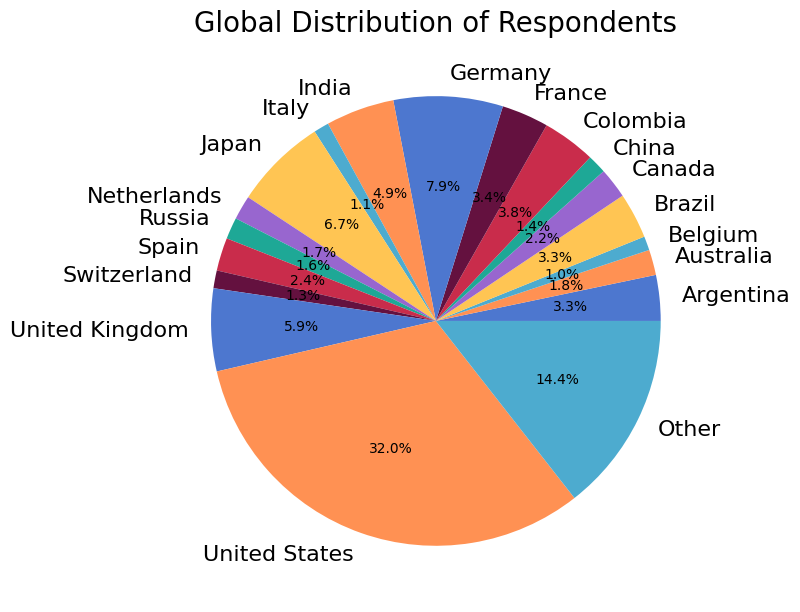
Africa: |
Cape Verde, Egypt, Ghana, Kenya, Morocco, Nigeria, South Africa, Togo |
Asia: |
Armenia, Bahrain, Bangladesh, Hong Kong, Indonesia, Iran, Israel, Malaysia, Nepal, Pakistan, Saudi Arabia, Singapore, Sri Lanka, Taiwan, Thailand, Turkey |
Europe: |
Albania, Austria, Belarus, Bosnia and Herzegovina, Bulgaria, Croatia, Czech Republic, Denmark, Estonia, Finland, Greece, Hungary, Ireland, Latvia, Norway, Poland, Portugal, Romania, Slovakia, Slovenia, Sweden, Ukraine |
North America: |
Costa Rica, El Salvador, Mexico |
Oceania: |
New Zealand |
South America: |
Bolivia, Chile, Ecuador, Paraguay, Peru, Uruguay, Venezuela |
Education#
1118 (90%) respondents shared their education history, spanning the range from pre-highschool graduation through Doctorate level with many other specialist degrees. The following figure summarizes the distribution for the most common types of degrees reported.
Show code cell source
degree = data['degree'][data['degree'] != '']
labels, cnts = np.unique(degree, return_counts=True)
fig, ax = plt.subplots(figsize=(8, 8))
ax.pie(cnts, labels=labels, autopct='%1.1f%%', labeldistance=None)
ax.set_title("Distribution of Highest Degree Obtained by Respondents")
ax.legend()
fig.tight_layout()
glue('num_education', gluval(degree.shape[0], data.shape[0]), display=False)
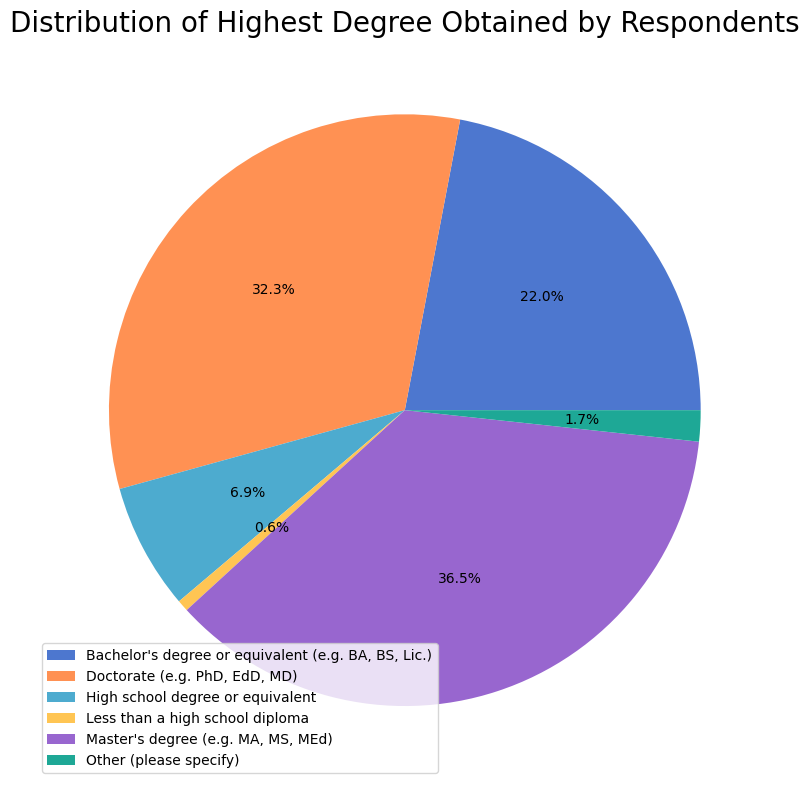
Job Roles#
464 (42%) of the 1106 respondents who shared their occupation identify as an PhD student, Software engineer, or Data scientist.
Show code cell source
role = data['role'][data['role'] != '']
labels, cnts = np.unique(role, return_counts=True)
# Sort results by number of selections
inds = np.argsort(cnts)
labels, cnts = labels[inds], cnts[inds]
fig, ax = plt.subplots(figsize=(12, 8))
ax.barh(np.arange(len(cnts)), cnts, align='center')
ax.set_yticks(np.arange(len(cnts)))
ax.set_yticklabels(labels)
ax.set_xlabel("Number of Respondents")
fig.tight_layout()
glue('num_occupation', role.shape[0], display=False)
glue(
'num_top_3_categories',
gluval(cnts[-3:].sum(), role.shape[0]),
display=False,
)
glue('top_3_categories', f"{labels[-3]}, {labels[-2]}, or {labels[-1]}", display=False)
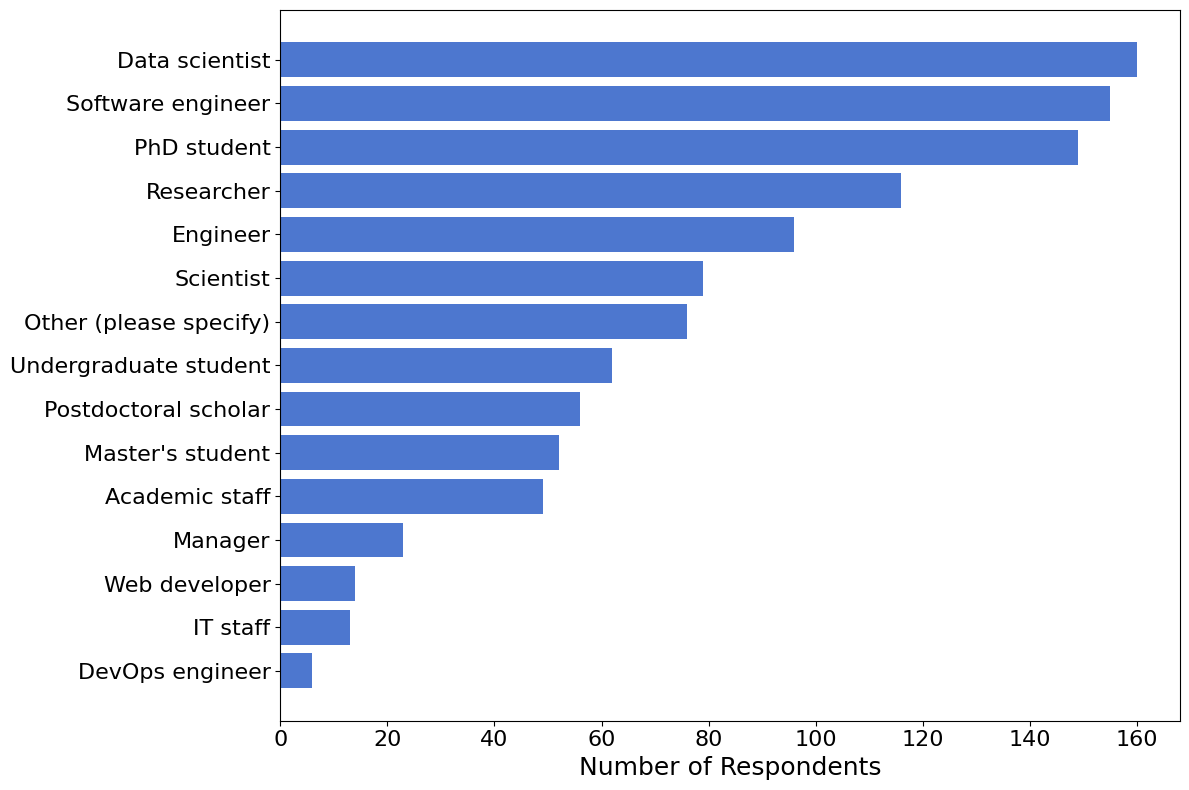
Experience and Usage#
Programming Experience#
63% of respondents have significant experience in programming, with veterans (10+ years) taking the lead. Interestingly, when it comes to using NumPy, noticeably more of our respondents identify as beginners than experienced users.
Show code cell source
fig, axes = plt.subplots(1, 2, figsize=(12, 6))
# Ascending order for figure
ind = np.array([-1, 0, 2, 3, 1])
for exp_data, ax in zip(('programming_exp', 'numpy_exp'), axes):
# Analysis
prog_exp = data[exp_data][data[exp_data] != '']
labels, cnts = np.unique(prog_exp, return_counts=True)
cnts = 100 * cnts / cnts.sum()
labels, cnts = labels[ind], cnts[ind]
# Generate text on general programming experience
glue(f'{exp_data}_5plus_years', f"{cnts[-2:].sum():2.0f}%", display=False)
# Plotting
ax.bar(np.arange(len(cnts)), cnts)
ax.set_xticks(np.arange(len(cnts)))
ax.set_xticklabels(labels)
axes[0].set_title('General Programming Experience')
axes[0].set_ylabel('Percentage of Respondents')
axes[1].set_title('Experience with NumPy');
fig.autofmt_xdate();
fig.tight_layout();
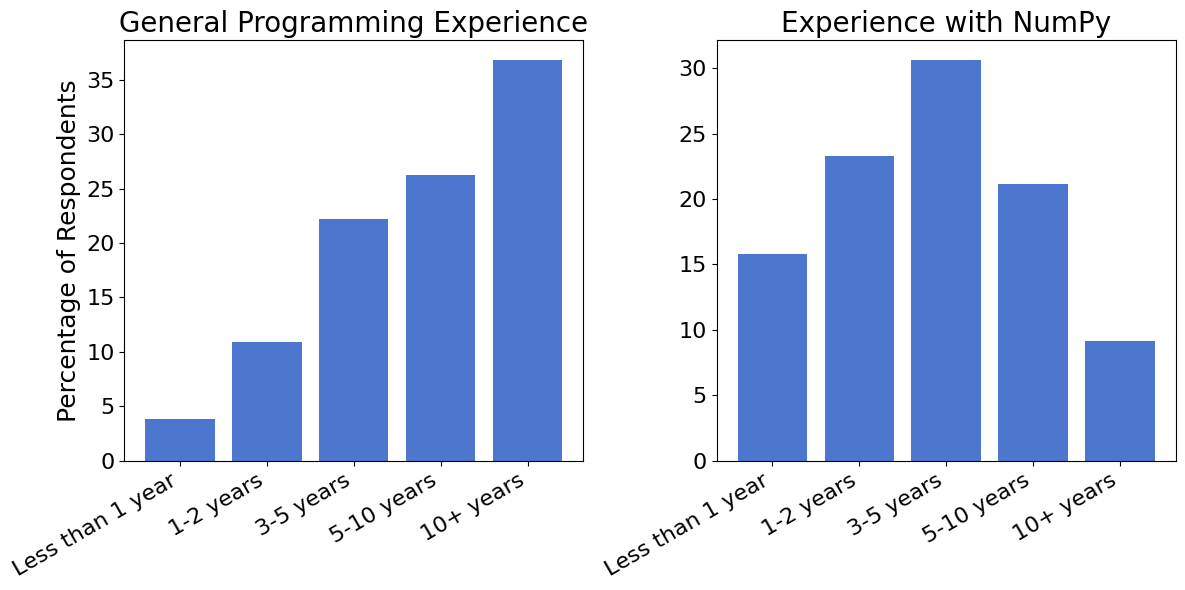
Programming Languages#
980 (79%) of survey participants shared their experience with other programming languages. 67% of respondents are familiar with C / C++, and 44% with Matlab.
Show code cell source
pl = data['prog_lang'][data['prog_lang'] != '']
num_respondents = len(pl)
glue('num_proglang_respondents', gluval(len(pl), data.shape[0]), display=False)
# Flatten & remove 'Other' write-in option
other = 'Other (please specify, using commas to separate individual entries)'
apl = []
for row in pl:
if 'Other' in row:
row = ','.join(row.split(',')[:-2])
if len(row) < 1:
continue
apl.extend(row.split(','))
labels, cnts = np.unique(apl, return_counts=True)
cnts = 100 * cnts / num_respondents
I = np.argsort(cnts)
labels, cnts = labels[I], cnts[I]
fig, ax = plt.subplots(figsize=(12, 8))
ax.barh(np.arange(len(cnts)), cnts, align='center')
ax.set_yticks(np.arange(len(cnts)))
ax.set_yticklabels(labels)
ax.set_xlabel("Percentage of Respondents")
ax.set_title("Programming Language Familiarity")
fig.tight_layout()
# Highlight two most popular
glue('num_top_lang', f"{cnts[-1]:2.0f}%", display=False)
glue('top_lang', str(labels[-1]), display=False)
glue('num_2nd_lang', f"{cnts[-2]:2.0f}%", display=False)
glue('second_lang', str(labels[-2]), display=False)
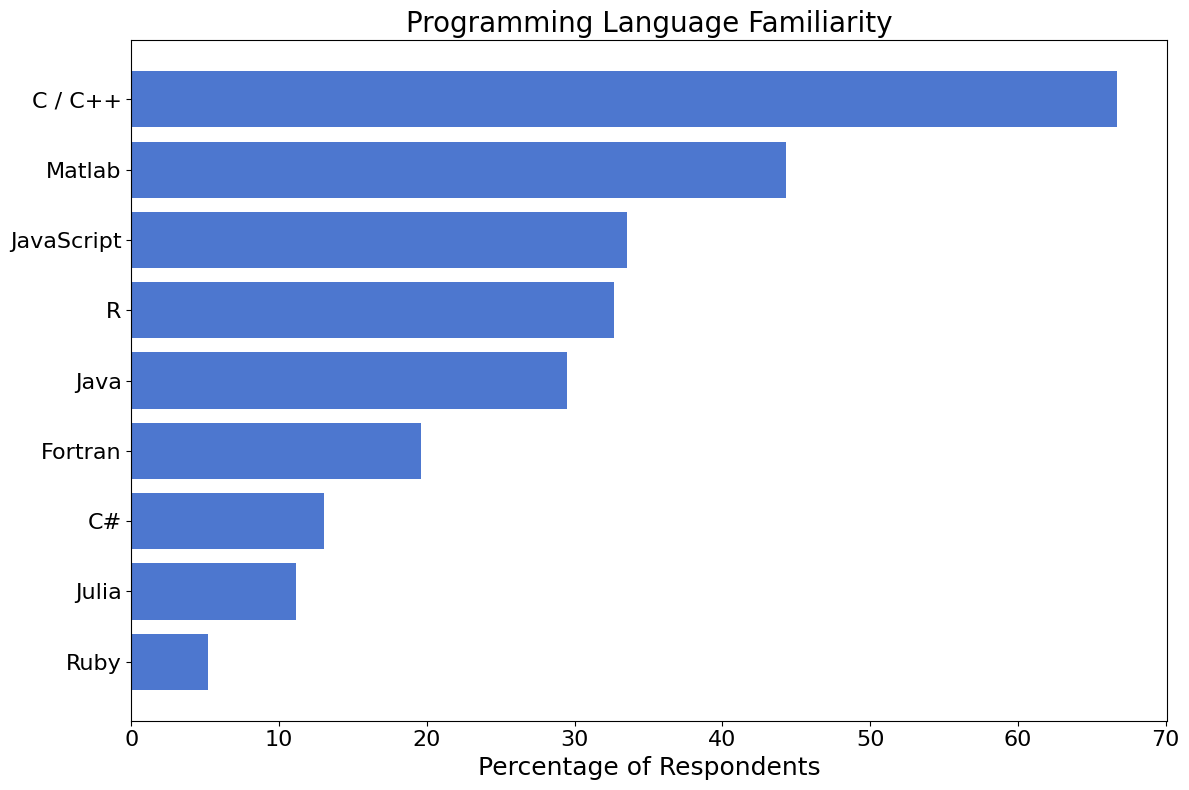
186 (19%) percent of respondents reported familiarity with computer languages other than those listed above. Of these, Rust was the most popular with 39 (4%) percent of respondents using this language. A listing of other reported languages can be found below (click to expand).
Show code cell outputs
['apl' 'asm' 'assembler' 'bash' 'basic' 'befunge' 'brainfuck' 'chapel'
'cobol' 'common lisp' 'crystal' 'cuda' 'dart' 'delphi pascal' 'elisp'
'emacs lisp' 'fame' 'flutter' 'go' 'golang' 'groovy' 'haskell' 'html'
'idl' 'igor pro' 'it counts!' 'kotlin' 'kuin' 'labview' 'latex' 'lisp'
'logo' 'lua' 'macaulay2' 'mathematica' 'modellica' 'netlogo' 'nim' 'node'
'oberon' 'ocaml' 'octave' 'pascal' 'perl' 'perl 5' 'php' 'postscript'
'processing' 'prolog' 'python' 'q#' 'racket' 'rust' 'sas' 'scala'
'scheme' 'shell' 'shellscript' 'smalltalk' 'solidity' 'spp' 'sql' 'swift'
'tcl' 'turbo pascal' 'turtle' 'typescript' 'unix'
'various assembly languages' 'vba' 'visual basic'
'visual basic for applications' 'visual basic 🥳' 'wolfram' 'xslt']
NumPy Version#
NumPy 1.18 was the latest stable release at the time the survey was conducted. 12.3 percent of respondents report that they primarily use an older version of NumPy.
Show code cell source
vers = data['version'][data['version'] != '']
labels, cnts = np.unique(vers, return_counts=True)
fig, ax = plt.subplots(figsize=(12, 8))
ax.pie(cnts, labels=labels, autopct='%1.1f%%')
fig.tight_layout()
# Percentage of users that use older versions
older_version_usage = 100 * cnts[-4:-1].sum() / cnts.sum()
glue('older_version_usage', f"{older_version_usage:1.1f}", display=False)
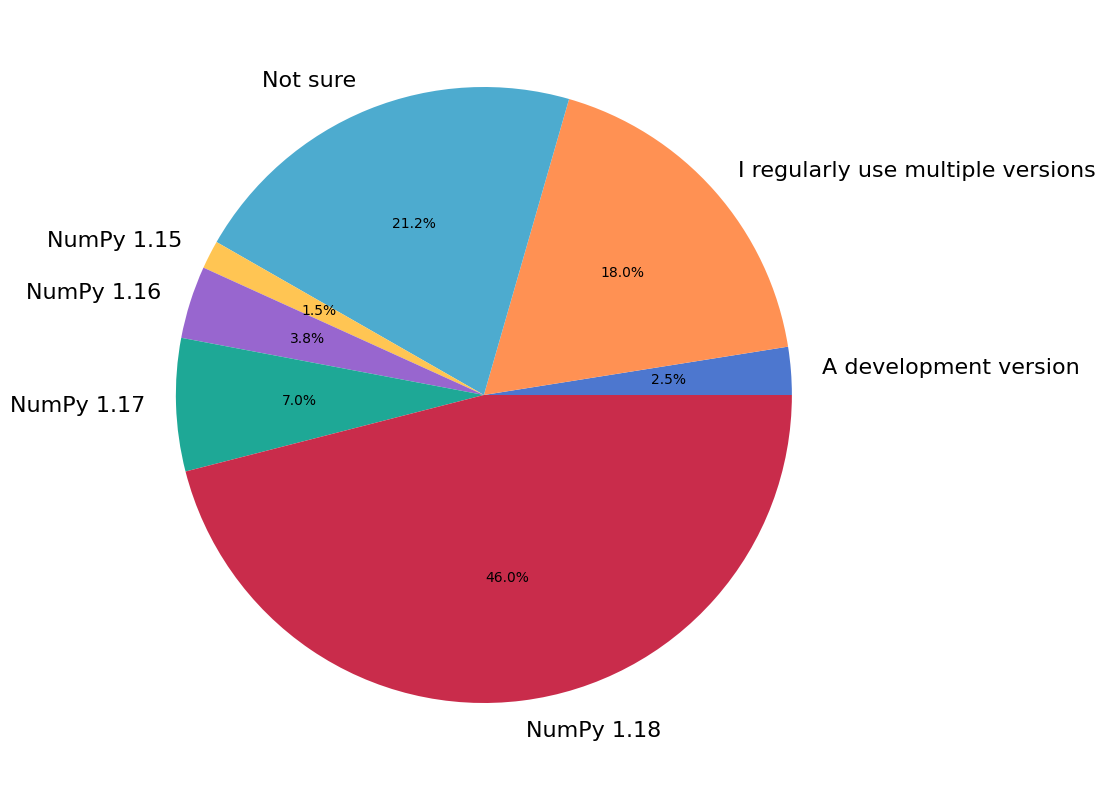
Primary Use-Case#
1072 (87%) respondents provided information about the primary context in which they use NumPy.
Show code cell source
uses = data['primary_use'][data['primary_use'] != '']
labels, cnts = np.unique(uses, return_counts=True)
fig, ax = plt.subplots(figsize=(12, 8))
ax.pie(cnts, labels=labels, autopct='%1.1f%%')
fig.tight_layout()
glue(
'num_primary_use_respondents',
gluval(uses.shape[0], data.shape[0]),
display=False
)
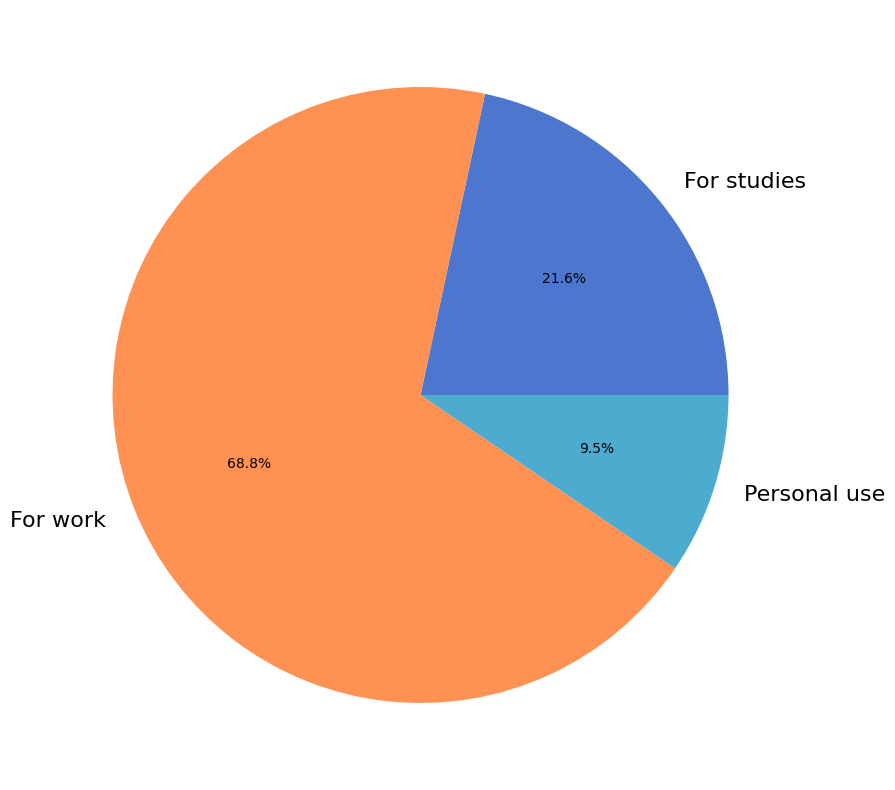
Frequency of Use#
1073 (87%) respondents provided information about how often they use NumPy.
Show code cell source
use_freq = data['use_freq'][data['use_freq'] != '']
labels, cnts = np.unique(use_freq, return_counts=True)
fig, ax = plt.subplots(figsize=(12, 8))
ax.pie(cnts, labels=labels, autopct='%1.1f%%')
fig.tight_layout()
glue('num_freq_respondents', gluval(use_freq.shape[0], data.shape[0]), display=False)
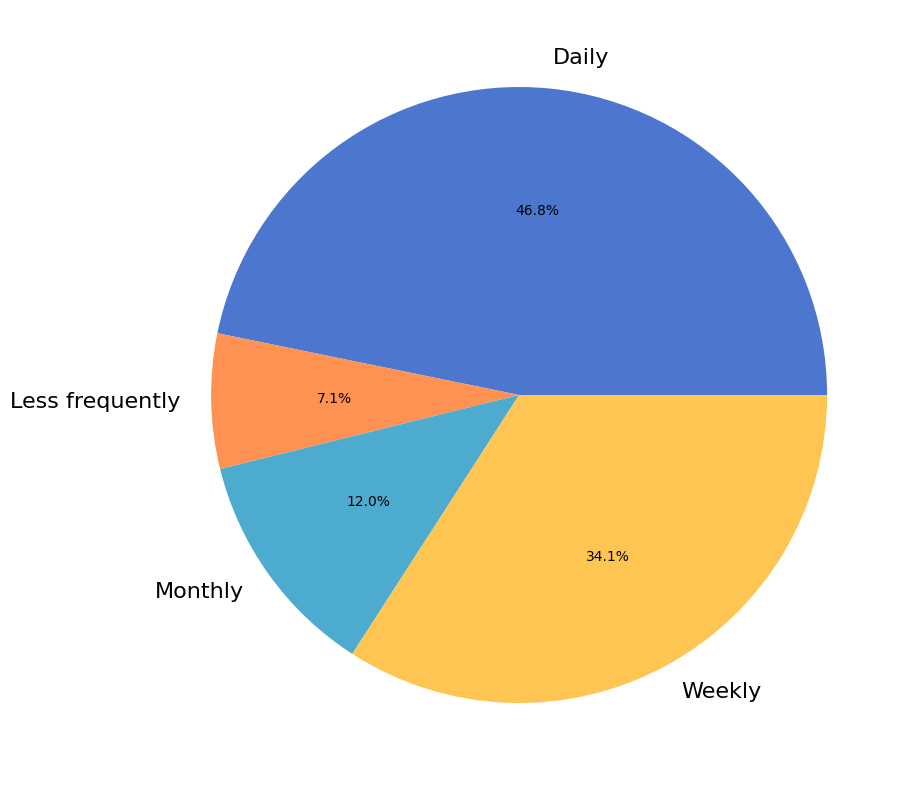
NumPy Components#
NumPy encompasses many packages for specific scientific computing tasks, such as random number generation or Fourier analysis. The following figure shows what percentage of respondents reported using each NumPy subpackage.
Show code cell source
components = data['components'][data['components'] != '']
num_respondents = len(components)
# Process components field
all_components = []
for row in components:
all_components.extend(row.split(','))
all_components = np.array(all_components)
labels, cnts = np.unique(all_components, return_counts=True)
# Descending order
I = np.argsort(cnts)
labels, cnts = labels[I], cnts[I]
cnts = 100 * cnts / num_respondents
fig, ax = plt.subplots(figsize=(12, 8))
ax.barh(np.arange(len(cnts)), cnts, align='center')
ax.set_yticks(np.arange(len(cnts)))
ax.set_yticklabels(labels)
ax.set_xlabel("Percentage of Respondents")
ax.set_title("Use-Frequency of NumPy Sub-Packages")
fig.tight_layout()
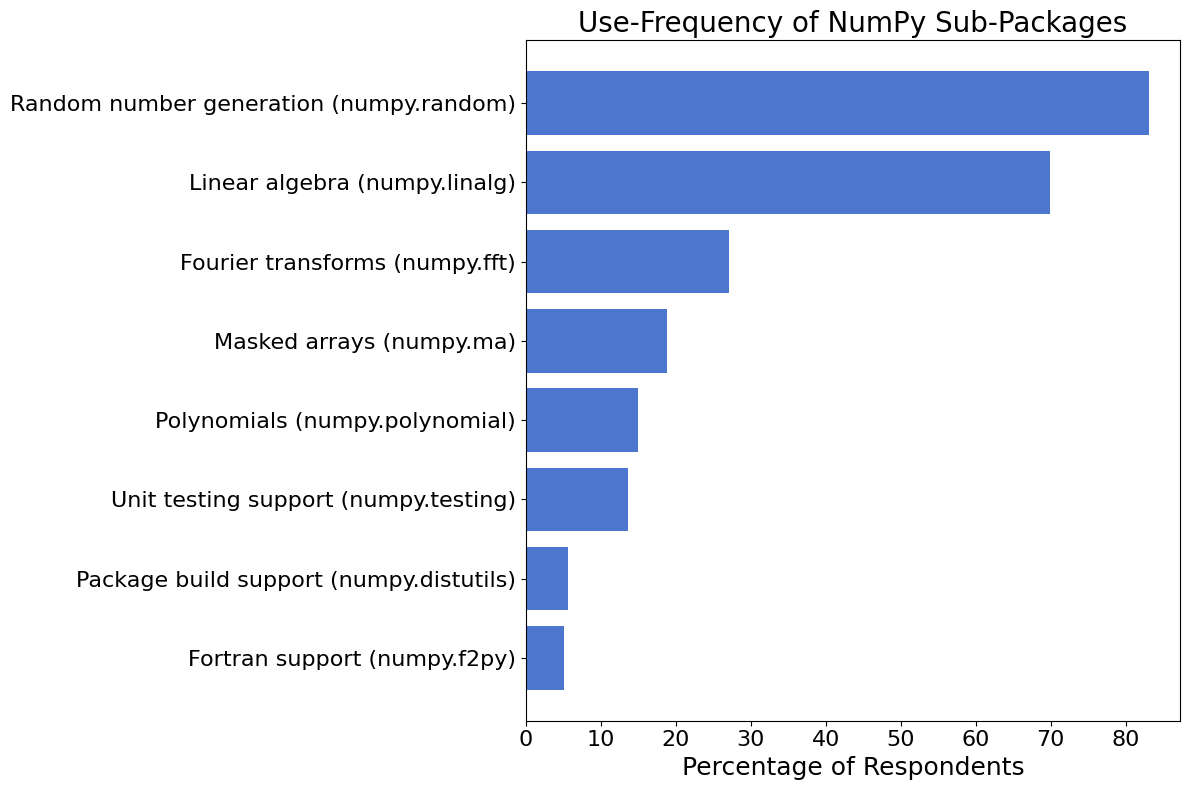
NumPy C-Extensions#
np.int64(863) participants shared whether they (or their organization) uses custom C-extensions via the NumPy C-API (excluding Cython).
Show code cell source
uses_c_ext = data['use_c_ext']
labels, cnts = np.unique(uses_c_ext, return_counts=True)
labels[0] = 'No response'
fig, ax = plt.subplots(figsize=(8, 8))
ax.pie(cnts, labels=labels, autopct='%1.1f%%')
fig.tight_layout()
glue('num_c_ext', np.sum(uses_c_ext != ''), display=False)
